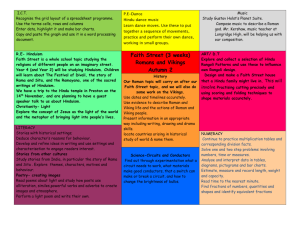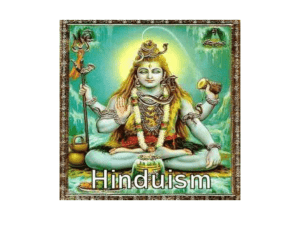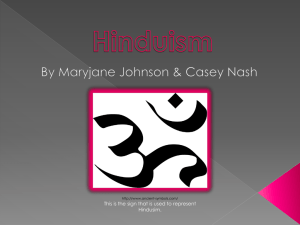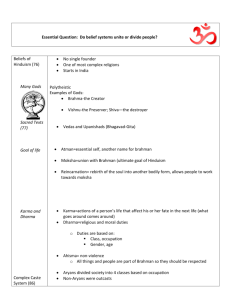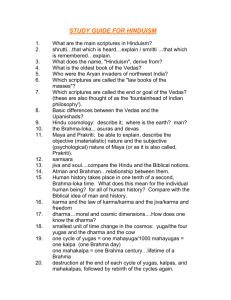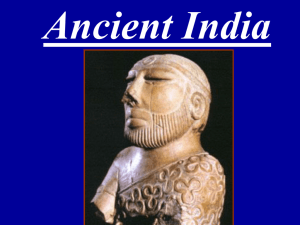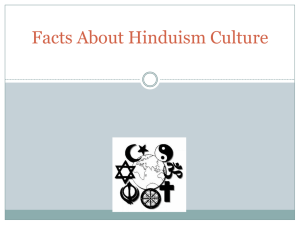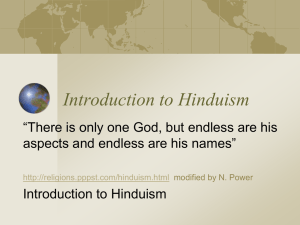Hinduism Unit Notes
advertisement
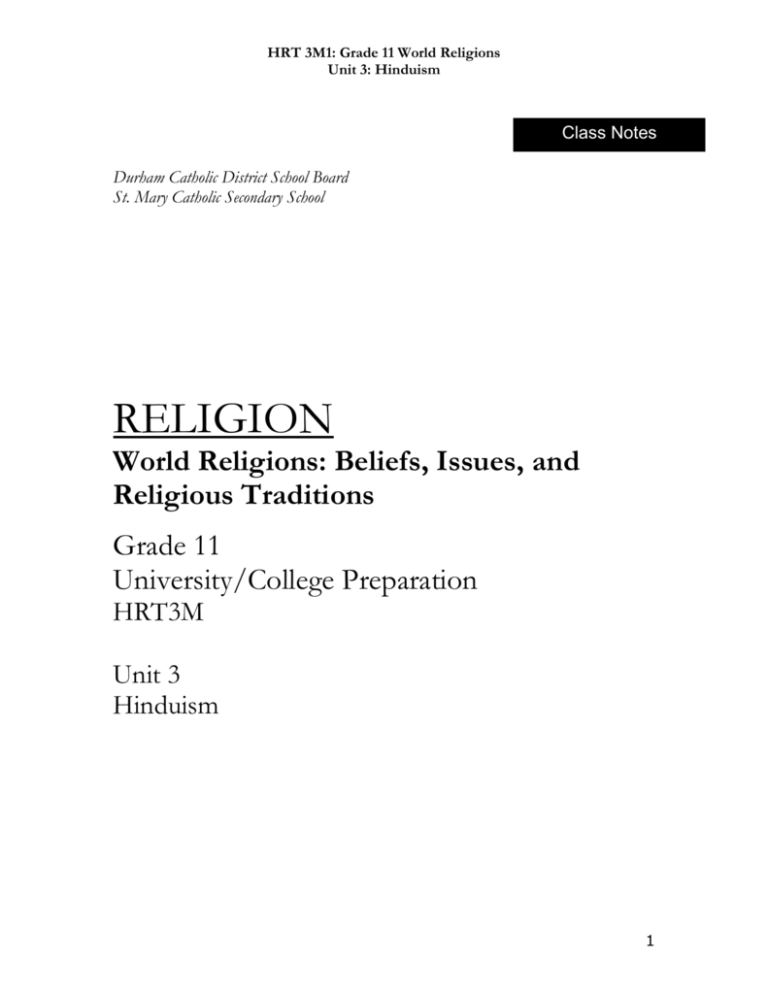
HRT 3M1: Grade 11 World Religions Unit 3: Hinduism Class Notes Durham Catholic District School Board St. Mary Catholic Secondary School RELIGION World Religions: Beliefs, Issues, and Religious Traditions Grade 11 University/College Preparation HRT3M Unit 3 Hinduism 1 HRT 3M1: Grade 11 World Religions Unit 3: Hinduism Terminology (Key Words): o Vedas o Moksha o Agni o Karma o Atman o Yoga (4 types) o Brahman o Samsara o Hindu Holy Trinity o Dharma o Brahma o The 5 levels of the Caste System o Vishnu o Ahimsa o Avatars o Mantras o Yogi o Puja o Shiva o The Ganges River o Maya o Shaivism o Parvati o Guru o Upanishads o Karma ______________________________________________________________________________________ The Origins of Hinduism Origins: Origins come from the Indus Valley of India, around 1500 BCE Hinduism is one of the Oldest religions known to mankind The word Hindu come from the Sanskrit word “sindhu” which means river (specifically the Indus River) Hinduism emerged as a religion by absorbing and incorporating many ancient faiths It has continually grown and expanded over hundreds of years Therefore Hinduism is referred to as Umbrella Religion because it is not a single, unified religion – it is a reservoir of complex beliefs and practices that have accumulated over five thousand years, sheltering many different religious beliefs. Brahman and Atman: Hindus do not believe in one God, but they believe that one reality rules the universe – this reality is called Brahman. Brahman has three main manifestations: 1. Brahma 2. Vishnu 3. Siva Brahman is everything and in everything. Brahman is unknowable to the rational mind – we can only know parts of Brahman. Hindus belief that humans are a part of Brahman… at the deepest core of all humans there is Brahman. The deepest human core is called Atman. Therefore, from a personal perspective, it is called Atman. Atman is Brahman and Brahman is Atman 2 HRT 3M1: Grade 11 World Religions Unit 3: Hinduism Basic Hindu Beliefs There is no founder There is no set creed of beliefs, therefore Hindus may practice their religion differently than their neighbor They believe in non-violence, this is called Ahimsa. To kill anything is to attack Brahman. They believe in Karma. Karma literally means action – everything that a person does rebounds upon their destiny According to the law of Karma, every person is born into a station of life that is determined by the deeds he/she has preformed in a past life. Good actions = positive results = rebirth to a higher level Bad actions = bad results = rebirth to a lower level The Caste System is a division of society and is based on your birth. It is related to karma. Samsara is the Hindu belief in reincarnation – a person must go through countless rebirths before achieving salvation. If you live your life with good karma, you will be born into a higher caste. If you live your life with bad karma, you will be born into a lower caste. Hindu Salvation: A Hindu’s ultimate goal in life is to reach Moksha: to stop the cycle of reincarnation and have their Atman return to Brahman. To do this you must truly know your Atman. However Maya stops us from knowing our Atman. Maya are the illusions that try to represent themselves as real things. Therefore to reach Moksha, one must have complete release from Maya. Hinduism is… Monism because everything is one (Brahman) Polytheism because Hindus believe in 330 Million Gods Hindu Gods Brahma: The Creator of the World He is often portrayed with four faces, embracing the four points of the compass, with four arms in which he holds the Vedas As Brahma is considered above and beyond worship, there are few temples dedicated to him Vishnu: The Preserver of the World He is often depicted as descending to earth in various forms, referred to as Avatars to uphold order. The god Krishna is the eighth avatar (the human incarnation of a god) Siddhartha Guatama the Buddha, founder of the Buddhist religion, is the ninth avatar of Vishnu. Siva: The Destroyer of the World Siva’s cosmic dance results in the world being burned to ashes He is portrayed wearing a necklace of skulls, his hair is tangled and matted. Siva calls human beings out of the world to liberate them. 3 HRT 3M1: Grade 11 World Religions Unit 3: Hinduism Cyclin Time Samsara also refers to the Hindu notion of time Periodically, after billions of years of existence, all of creation is dissolved and enters a state of suspended being when Brahman alone exists At the end of these rest periods, the world is recreated, society is reformed, and the scriptures are recomposed The Hindu view is that history repeats itself every billion or more years in never-ending cycles of creation and destruction 4 HRT 3M1: Grade 11 World Religions Unit 3: Hinduism Assignment 3.1 Hindu Holy Trinity In your readings and in class we covered new information on Hinduism that dealt with the tree main Hindu Gods, who together are referred to as the Trimurti. Create a flow chart that names, identifies and fully explains the function of each of the tree gods covered in classroom material. In addition, please identify what aspect of the Christian Holy Trinity each of these three gods could be compared to and toe similarities that they appear to share. Total Inquiry Mark: 30 Example: 5 HRT 3M1: Grade 11 World Religions Unit 3: Hinduism Hindu Paths to Salvation There are four ways that a Hindu can reach Moksha (eternal salvation) and total Atman/Brahman union. These are called paths. Personality Emotional Person Activist Person Reflective Person Extremist Person Yoga Bhakti Karma Jnana Raja Techniques Loving attitude towards all Charitable deeds, building karma Mental Prayer and Contemplation Mind over matter exercises and out of body experience 1. The Path of Devotion (Bhakti Yoga) One of the Hindu holy scriptures called the Mahabarata contains a long poem called the Bhagavad Gita. This poem tells of the adventures of the god Krishna. Krishna teaches the worship that most Hindu follow, called Bhakti. Bhakti is devotion to a particular God. Here moksha is achieved through constant acts of worship, called Puja. Puja can be preformed at a home alter or in a temple 2. The Path of Action (Karma Yoga) This requires renunciation (giving up) of the things of this world (also called asceticism) to remove Maya. This path to mohsha is achieved through dharma. There are four stages along the Path of Action: a. Student: 10-20 years of study under the guidance of a teacher (guru) and the practice of chastity and other virtues. b. Householder: marriage and faithful fulfillment of duties to family, caste and community. c. Hermit: sexual abstinence and retirement into solitude for meditation and prayer. d. Spiritual Pilgrim: a return to society as a wandering ascetic in preparation for death and final liberation (moksha). 3. The Path of Knowledge (Jnana Yoga) Knowledge can assist a Hindu in reaching salvation. This is not meant to be understood as intellectual knowledge but a true, whole realization that Atman and Brahman are one. To achieve this requires deep mediation. Many types of physical yoga are used to enter and maintain this state of meditation. They also concentrate on mandalas and continuously repeat mantras. The most sacred mantra involves repeating the syllable “OM”. OM is thought to be the living deity, Brahman. 4. The Path of Meditation (Raja Yoga) Followers of this path use deep meditation to reach moksha. Intense meditation may lead to a trance-like state where individuals can acquire knowledge of their Atman and become one with Brahman. This path requires strict physical and spiritual discipline. 6 HRT 3M1: Grade 11 World Religions Unit 3: Hinduism The Caste System In Hinduism there are four main divisions of society which are called castes. However, in modern India today, there are about three thousand rigidly fixed castes in India. The Caste system is more than just a convenient organization of people in society based entirely on the circumstances of birth… the Hindu Caste system has deep religious significance too. Whereas Hinduism allows for greater freedom of beliefs, it’s Caste system places greater restriction on behaviour. About the Caste System: 1. Each person is locked into the caste in which he or she was born 2. Escape from a caste is not possible until death 3. Fidelity to Dharma (that means Duty) requires that a person submit willingly to the social status, occupation, eating habits, dress and religious ritual prescribed for his or her caste. 4. It is not possible to move into a higher caste… rather, a person must be born into a higher caste. In short, according to Hindu thinking, unless one achieves total union with Brahman, death is the point where your atman is reborn into another form. To achieve total union with Brahman, one must either be born into and die from within the Brahmin Caste, or undergo Moksha from within another Caste. The Caste System Today: Today in India, public discrimination against the lowest Castes and the outcastes is illegal. However, the caste system is still a part of Hindu society. 7 HRT 3M1: Grade 11 World Religions Unit 3: Hinduism The Four Goals of Life Classic Hinduism promotes four different goals. Like other aspects of Hinduism, the goal is split between those emphasized by the “life is good” perspective and those emphasized by the “life is bad perspective. The three life-affirming goals are Dharma (Virtue), Artha (Success) and Karma (Pleasure), while the life-negating goal is that of Moksha (Release). The Three “life is good” goals can be perused all at once or at different times in one’s life. Some goals seem more suited to different stages of life than others. Dharma is the practice of virtue, the living of an ethical and ritually correct life. The definition of what is virtuous however, varies, depending on a person’s caste membership. The primary virtue is to fulfill the duties assigned to one’s caste. Thus a Brahmin should offer sacrifices and do them to the best of his ability, while a Vaishya silversmith should create his plates and bowls as strong and as beautiful as possible. If either person tried to do the others job, that would be seen as a violation of Caste duty. The dharma a person is expected to fulfill also varies depending of their stage of life. A student, for instance, becomes virtuous through a different set of action than a householder. Artha is the working for and achieving of success, in terms of both wealth and power. This means it is religiously proper to be a successful businessman. It also means that it is religiously good to serve on city council, be active in civic organizations, or even become a politician. This kind of success is most easily achieved at the householder stage of life. Kama is pleasure, usually understood as aesthetic pleasure of all kinds. This includes the producing and enjoyment of art, music, dance, drama, literature, poetry and sex. The Kama Sutra, which may be one of the best known Hindu texts I the West, is all about the aesthetic pleasure of men and women; it discusses beauty, music dance and sexual activity. It is thus religiously praiseworthy to take part, to support, or just to appreciate any form of pleasure. This should always be done, of course, within the realm of dharma (i.e. Virtuous manor). The “life is bad” goal is moksha. It is the striving for release from life (since, after all, it is bad). To achieve this, a person must turn their back on life and strive to live without the things that make up life. At first, it requires the turning away from the first three goals, of rejecting family, comforts, pleasure, education, and so on. It also requires one to become an ascetic, a hermit, ad to spend one’s time in contemplation. This contemplation should be directed towards overcoming the maya that clouds the human perception of reality and towards realizing the true nature of the cosmos and one’s place in it (that atman and Brahman are one). ______________________________________________________________________________________ The Main Differences between Hinduism and Catholicism Hinduism Salvation is self directed… It depends on your own efforts Many Gods (Polytheism) No fixed teachings, or sacred books Reincarnation… The soul gets as many chances as it needs Each atman can be in many different persons Goal of life is to disappear (moksha) Priests direct rituals but do not perform rituals Catholicism Only Jesus can save us from our sins One God (Monotheism) Official set of teachings, books (bible) and morality The soul gets only one chance Only one soul to one person Goal of life is eternal happiness with God Priests perform many rituals 8 HRT 3M1: Grade 11 World Religions Unit 3: Hinduism Hinduism – Aspects of Life: Festivals and Rights of Passage In the next few days, you will be working either on your own, or in groups of two, on an oral presentation. You will present an aspect of Hindu life to your classmates. 1. 2. 3. 4. You will select a topic You will research the topic, either using the text, other books or the internet In your presentation, show a) How the aspect of Hindu life came to be (the history of the event) b) Why the aspect of Hindu life is important c) How is it similar/different from Christianity d) The Hindu religious and cultural meaning of the event, the social function it serves and the emotional and psychological function it provides You must have a Fact Sheet (handout) for each student that is either highlighting points you make or includes points you haven’t made. The handout should not be your notes, it should be a well organized summary of information that is clear, and legible. This is your chance to be as creative as you want – Presentations will be 10 minutes in length. If you work in a group of two, be sure to divide the work evenly so that it is not necessary to get together to complete the assignment. Excuses for not completing the assignment in time for your presentation will not be tolerated. Note to Student: Everyone should be ready to present on the first day (no exceptions – you will receive a mark of Zero (0) of you fail to present on your day) Upon presenting, students must hand in to the teacher a copy of the rubric, and student/presentation information filled out. Please refer to the Rubric for a guideline of further expectations. 9 HRT 3M1: Grade 11 World Religions Unit 3: Hinduism Hinduism – Aspects of Life: Festivals and Rights of Passage Name of Students: 1.______________________________________, 2._________________________________________ Presentation Topic: _______________________________________________ Description of the Aspect investigated: ______________________________________________________________________________________ ______________________________________________________________________________________ ______________________________________________________________________________________ ______________________________________________________________________________________ ______________________________________________________________________________________ Criteria Knowledge & Understanding 10 Marks Thinking & Inquiry 10 – 9 Demonstrated a thorough knowledge and understanding of topic area and Hinduism. Evidence of excellent research shown. Demonstrated a very high degree of interpretation and analysis of the material - making it easily understandable to the class – Great test questions 8–7 Showed considerable knowledge and understanding of topic area and Hinduism. Evidence of good research shown. Demonstrated a good level of interpretation and analysis of the material making it understandable to the class – Good test questions 6–5 Showed a basic level of knowledge and understanding of topic area and Hinduism. Evidence of some research shown. Demonstrated a basic level of interpretation and analysis of the material - making it understood by the class – Basic test questions Excellent sense of audience and purpose. Little or no reference made to written notes. Highly professional in appearance and deportment. Good sense of audience and purpose. Some reference made to written notes. Somewhat professional in appearance and deportment. General sense of audience and purpose. Relied heavily on written notes. Lacking in professional appearance and deportment. Excellent use of the handout material. Little or no, repetition in your oral presentation. Excellent professional formatting. Good use of the handout material. Some repetition in your oral presentation. Somewhat professional in formatting. Superb organization evident. An excellent variety of vocal intonations and expression evident in presentation. Presentation was highly creative and kept the audience attention consistently throughout the presentation Some good organization evident. Some variety of vocal intonations and use of expression was evident in presentation. Presentation was somewhat creative and kept the audience attention frequently throughout the presentation General use of the handout material. Highly repetitive of your oral presentation. Lack of professional formatting. Limited organization present. A limited variety of vocal intonations and expression evident in presentation. Limited creativity in the presentation and kept the audience attention sporadically throughout the presentation. 5 Marks Oral Communication of Material 5 marks Written Communication of Material 5 Marks Application Organization and creativity of the entire Presentation 5 Marks Below 5 Failed to demonstrate adequate knowledge and understanding of topic area and Hinduism. Little or no evidence of research shown. Did not demonstrated an acceptable of interpretation and analysis of the material making it difficult to understand – Test questions were not sufficient Very limited sense of and purpose. Presentation was entirely read to the class from notes. Not professional in appearance or deportment. Limited use of handout material. An exact copy of your oral presentation. Formatting was not professional. Not well organized. A variety of vocal intonations and expression was not evident in presentation. No creativity in the presentation and did not keep the audience attention during the presentation 10 HRT 3M1: Grade 11 World Religions Unit 3: Hinduism Sacred Writings Unlike other religions which have only one book (e.g. The Bible), Hinduism has a number of sacred texts. The Vedas: The Four Vedas are considered the oldest Hindu Scriptures. They deal with subjects ranging from the divine sprit to medicine and science. Each Vedas contains the following type of compositions: o Mantras: songs of praise o Brahmanas: manual for priests on prayer and ritual o Aranyakas: “forest books” for saints and hermits o Upansishads: philosophical commentary at the end of each Vedas, discussing topics such as the mind, the senses, worship, meditation, and the many means of liberation from maya. The Ramayana and the Mahabharata: These are India’s two great epic stories that teach Hindu ideals of moral conduct. o Ramayana: the story of prince Rama, who was worshiped as the seventh avatar (incarnation) of Vishnu, who was banished to the forest so that his brother could become king. Sita, Rama’s wife, tried to rescue her husband but was taken by Ravana. A battle took place where Rama, assisted by the king of the monkeys (Hanuman), defeated Ravana rescued Sita and returned to his kingdom. o Mahabharata: a story of two forces, the Pandavas (good) and the Kauravas (evil). There is a war between evil princes and good princes, eventually the good defeats the evil and rule for many years. The Puranas (myths): This literature describes the gods – each chapter begins with the name of the god and then tells its’ legend. These are used by temple priests Manusmriti (The Laws of Manu): This Hindu law book affirms the concepts of Dharma, Caste, and the Four Aims of Life. It deals with religious practice, law, customs, and politics. 11 HRT 3M1: Grade 11 World Religions Unit 3: Hinduism Assignment 3.1: Gandhi Video Reflection Write a 3 page reflective essay on the film using the points given below along with your own thoughts of the video. The essay must be single spaced, 12 point font, Times New Roman font. No longer, no shorter! Issues to investigate: o How Gandhi’s education helped him in his fight with the British Government o Gandhi’s appearance change from the beginning of the video to the end o Gandhi’s reference to Bible passages when he was a Hindu o Comparisons throughout the video to Jesus. They called Gandhi “Bapu” and “Mahatma”. What do these terms mean. “He” his coming… o What exactly Gandhi fought against in South Africa and in India… Living in an Ashram… Gandhi’s starvation tactic to achieve peace o Burning of the British cloth, making salt, wearing homespun cloth o The massacre at Amritsar o The beatings at the Dhavasana Salt Works o The conflict between Hindus and Muslims. Explain the historical development and what is the situation is like today. o “The sun never sets on the British Empire” o “An eye for an eye only makes the whole world blind” ______________________________________________________________________________________ Assignment 3.2: Untouchable Essay After reading the article, Untouchable (National Geographic, June 2003) compose an essay that addresses the following question: Some suggestions to explore: o Exploitation o Anonymous o Hopeless How are untouchables castebound victims? Suggested Essay outline: 1. 2. 3. Introduction a. Introductory statements b. Thesis statement c. Introduce supporting ideas Body a. First supporting idea i. Transition, topic sentence ii. Discussion, examples, and analysis iii. Conclusion b. Second supporting idea i. Transition, topic sentence ii. Discussion, examples, and analysis iii. Conclusion c. Third supporting idea i. Transition, topic sentence ii. Discussion, examples, and analysis iii. Conclusion Conclusion a. Transition, statement reflecting back on thesis b. Restate key points c. Ending statement that provokes thought (optional) 12 HRT 3M1: Grade 11 World Religions Unit 3: Hinduism Criteria Knowledge & Understanding 10 – 9 Demonstrated a thorough knowledge and understanding of the issues raised 8–7 Showed considerable knowledge and understanding of the issues raised 6–5 Showed a basic level of knowledge and understanding of the issues raised Below 5 Failed to demonstrate adequate knowledge and understanding of the issues raised Demonstrated a very high degree of interpretation and analysis of the material - making it easily understandable to the reader Excellent sense of audience and purpose. Highly professional in appearance and deportment. Essay flowed extremely smoothly and logically. Superb organization evident. Student was able to apply all of the outlined requirements with excellence. Demonstrated a good level of interpretation and analysis of the material - making it understandable to the reader Demonstrated a basic level of interpretation and analysis of the material - making it understood by the reader Did not demonstrated an acceptable of interpretation and analysis of the material - making it difficult to understand Good sense of audience and purpose. Somewhat professional in appearance and deportment. Essay flowed smoothly and logically. General sense of audience and purpose. Lacking in professionalism in appearance and deportment. Essay flowed somewhat smoothly and logically. Limited organization present. Student was able to apply some of the outlined requirements. Very limited sense of audience and purpose. Not professional in appearance or deportment. Essay did not flow smoothly or logically. 10 marks Thinking & Inquiry 10 marks Communication 10 marks Application 10 marks Some good organization evident. Student was able to apply most of the outlined requirements. Not well organized. Student was not able to apply any of the outlined requirements Total Mark ____/40 13

